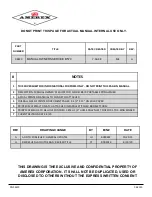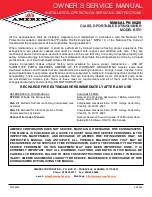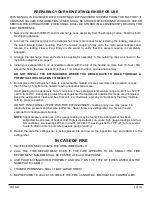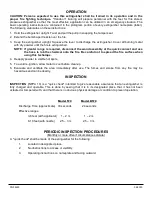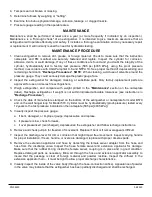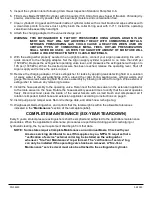
PN 08220
04/2020
PREPARING YOUR NEW EXTINGUISHER FOR USE
THIS MANUAL IS PACKAGED WITH EVERY NEW EXTINGUISHER SHIPPED FROM THE FACTORY. IT
CONTAINS VALUABLE INFORMATION, WHICH SHALL BE STUDIED BY EVERYONE WHO WILL USE OR
SERVICE THE EXTINGUISHER. THE MANUAL SHALL BE STORED IN A CONVENIENT LOCATION FOR
EASY REFERENCE.
1.
Remove the Model 570/B570 and its discharge hose assembly from the shipping carton. Examine both
for shipping damage.
2.
Connect the wand assembly to the extinguisher hose male connector by retracing the locking sleeve on
the wand female swivel coupling. Push the female coupling firmly onto the male swivel adapter and
release the locking sleeve. Tug firmly on the wand to verify that the swivel coupling is completely
engaged.
3.
Arrange the discharge hose and extension applicator assembly in the retaining clips as shown in the
installation diagrams on page 9.
4.
Install your extinguisher in an accessible location with the top of the handle no more than 3½ feet (.1M)
above the floor, the base at least 4 inches (.1 m) above the floor, and near a doorway.
DO NOT INSTALL THE EXTINGUISHER WHERE YOU WOULD HAVE TO WALK THROUGH A
POTENTIAL FIRE LOCATION TO REACH IT!
5.
Do not place this extinguisher close to a potential fire hazard. Amerex recommends a location no less
than 50 feet (15 m) from the hazard, leaving unobstructed access.
Avoid placing it in an extremely hot or cold place. The operational temperature range is
-
40°F to +120°F
(
-
40°C to +49°C). Adequately protect the extinguisher if temperatures outside this range are anticipated.
Keep the extinguisher clean and free from dirt, ice, chemicals, and any contaminants that may interfere
with its proper operation.
DO NOT FUNCTIONALLY TEST THIS FIRE EXTINGUISHER –
testing or any use may cause it to
gradually lose pressure and become ineffective. Never throw any extinguisher in a fire as it could
explode from heat/pressure buildup.
NOTE
: Slight pressure variances in the gauge reading may be found if the extinguisher has been
subjected to extremes of heat or cold. High temperatures can cause high gauge readings and low
temperatures, low readings. When in doubt, condition the extinguisher to 70°F (21°C) for several
hours to obtain a more accurate pressure gauge reading.
6.
Record the date the extinguisher is being placed into service on the inspection tag, and attach it to the
extinguisher.
IN CASE OF FIRE
1.
HAVE EVERYONE EVACUATE THE AREA IMMEDIATELY!
2.
CALL THE FIRE DEPARTMENT EVEN IF THE FIRE APPEARS TO BE SMALL! THE FIRE
DEPARTMENT NUMBER SHALL BE POSTED AT EACH TELEPHONE.
3.
USE YOUR EXTINGUISHER PROPERLY AND ONLY ON THE TYPE OF FIRES LISTED ON THE
NAMEPLATE (LABEL)!
4.
TRAINED PERSONNEL SHALL FIGHT LARGE FIRES!
5.
BE PREPARED TO LEAVE THE AREA IF THE FIRE CANNOT BE IMMEDIATELY CONTROLLED!

